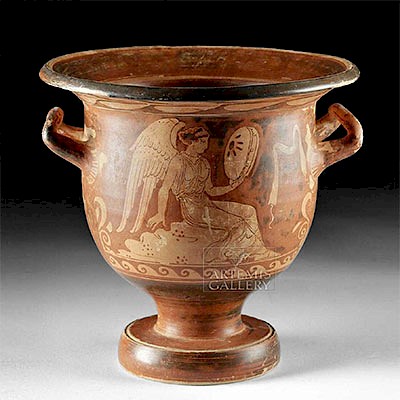18th C. Russian Tripartite Icon - Superb!
Lot 278
About Seller
Artemis Gallery
686 S Taylor Ave, Ste 106
Louisville, CO 80027
United States
Selling antiquities, ancient and ethnographic art online since 1993, Artemis Gallery specializes in Classical Antiquities (Egyptian, Greek, Roman, Near Eastern), Asian, Pre-Columbian, African / Tribal / Oceanographic art. Our extensive inventory includes pottery, stone, metal, wood, glass and textil...Read more
Estimate:
$2,000 - $3,000
Absentee vs Live bid
Two ways to bid:
- Leave a max absentee bid and the platform will bid on your behalf up to your maximum bid during the live auction.
- Bid live during the auction and your bids will be submitted real-time to the auctioneer.
Bid Increments
| Price | Bid Increment |
|---|---|
| $0 | $25 |
| $300 | $50 |
| $1,000 | $100 |
| $2,000 | $250 |
| $5,000 | $500 |
| $10,000 | $1,000 |
| $20,000 | $2,500 |
| $50,000 | $5,000 |
| $100,000 | $10,000 |
| $200,000 | $20,000 |
About Auction
By Artemis Gallery
Mar 7, 2019
Set Reminder
2019-03-07 10:00:00
2019-03-07 10:00:00
America/New_York
Bidsquare
Bidsquare : VARIETY SALE | Antiquities & Ethnographic Art
https://www.bidsquare.com/auctions/artemis-gallery/variety-sale-antiquities-ethnographic-art-3928
Around the world & back in time - be amazed at the treasures you will find. Antiquities from Egypt, Greece, Italy and the Near East, Asian, Pre-Columbian, African / Tribal / Oceanic, Native American, Spanish Colonial, Russian Icons, Fine Art, much more! Artemis Gallery info@artemisgallery.com
Around the world & back in time - be amazed at the treasures you will find. Antiquities from Egypt, Greece, Italy and the Near East, Asian, Pre-Columbian, African / Tribal / Oceanic, Native American, Spanish Colonial, Russian Icons, Fine Art, much more! Artemis Gallery info@artemisgallery.com
- Lot Description
Eastern Europe, Russia, ca. 1720 to 1740 CE. A very special icon finely delineated in egg tempera, gold leaf, and varnish on wood with an engaging tripartite composition. The upper left panel features the Mother of God holding the Christ child in one arm, as he makes a blessing gesture. On her shoulders and head, Mary wears a triple, star-shaped cross, which is an ancient symbol of her virginity - before, during, and following the birth. The Anastasis scene, also known as the Harrowing of Hell, on the upper right, shows Christ holding the Cross, resurrected and breaking down the doors of hell, holding Adam's hand with Eve kneeling in her tomb (Adam and Eve being the first progenitors), crowned kings (David and Solomon) and prophets from the Old Testament. Below these, the largest panel presents Christ with prophets and kings. In addition to this rich iconography, this icon is impressive for how it has aged so gracefully. Just look at that remarkable craquelure across the composition. Size: 12.25" L x 10.75" W (31.1 cm x 27.3 cm)
Icons were some of the first religious artworks brought to Russia from Byzantium. These sacred pictures of the Greek Orthodox church reached a high point in the Byzantine era, however, the Russians brought their own style to the art of the icon. Icons were initially created for use in churches and processions. In time they became smaller and were used increasingly within households. To this day they remain an important form of visual culture in Russia's orthodox religious community.
Provenance: private Ventura County, California, USA collection
All items legal to buy/sell under U.S. Statute covering cultural patrimony Code 2600, CHAPTER 14, and are guaranteed to be as described or your money back.
A Certificate of Authenticity will accompany all winning bids.
We ship worldwide and handle all shipping in-house for your convenience.
#122500Expected surface wear, darkening, and abraded areas / losses commensurate with age. Nevertheless, this icon has aged gracefully with marvelous craquelure on the surface.Condition
- Shipping Info
-
All shipping is handled in-house for your convenience. Your invoice from Artemis Gallery will include shipping calculation instructions. If in doubt, please inquire BEFORE bidding for estimated shipping costs for individual items.
-
- Buyer's Premium



 EUR
EUR CAD
CAD AUD
AUD GBP
GBP MXN
MXN HKD
HKD CNY
CNY MYR
MYR SEK
SEK SGD
SGD CHF
CHF THB
THB















